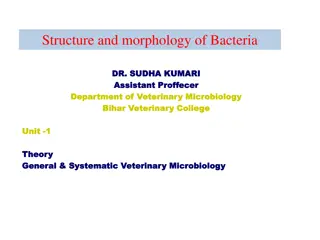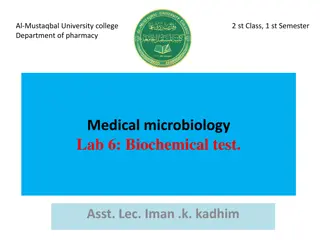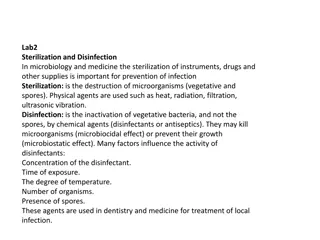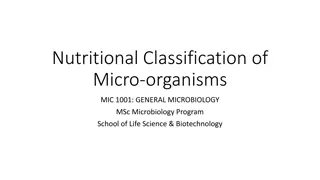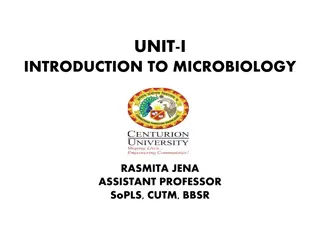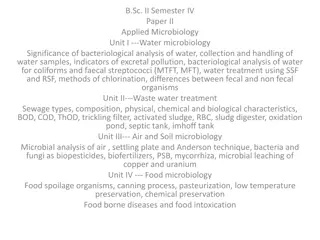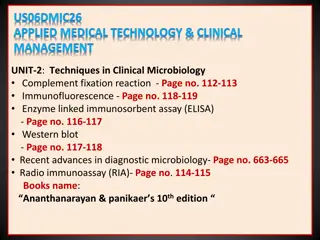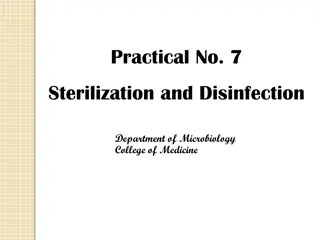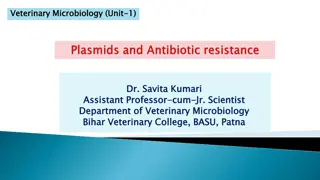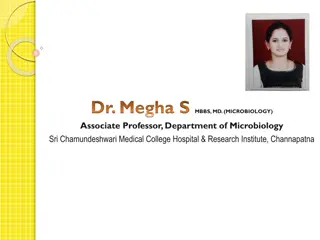Department of Microbiology.
In the field of microbiology, different types of bacterial cultures are utilized for various purposes. Batch cultures, such as shake-flask cultures, offer advantages like reduced risk of contamination and flexibility with product systems. However, they also have drawbacks, such as lower productivity levels and increased costs. Applications of batch cultures include producing products with minimal contamination risk and small-scale production processes. Continuous cultures, on the other hand, involve the continuous supply of nutrients and removal of end products. Both types of cultures play a crucial role in microbiology research and industrial applications.
Download Presentation

Please find below an Image/Link to download the presentation.
The content on the website is provided AS IS for your information and personal use only. It may not be sold, licensed, or shared on other websites without obtaining consent from the author.If you encounter any issues during the download, it is possible that the publisher has removed the file from their server.
You are allowed to download the files provided on this website for personal or commercial use, subject to the condition that they are used lawfully. All files are the property of their respective owners.
The content on the website is provided AS IS for your information and personal use only. It may not be sold, licensed, or shared on other websites without obtaining consent from the author.
E N D
Presentation Transcript
Types of Bacterial Cultures (For B. Sc. II semester) Dr Deepak V. Vedpathak Associate Professor, Department of Microbiology. Rajarshi Shahu Mahavidyalaya (Autonomous), Latur (MS) Dr DVV, LTR/2020
Batch culture (shake-flask culture) A closed culture system in which nutrients are not renewed and metabolic products are not removed The medium composition, biomass concentration and metabolite concentration generally change constantly as a result of metabolism The culture pass through the six typical phases of growth A typical microbial flask cultures in the laboratory is a batch culture Dr DVV, LTR/2020
Advantages of Batch culture 1 Reduced risk of contamination or cell mutation as the growth period is short 2 Lower capital investment when compared to continuous processes for the same bioreactor volume 3 More flexibility with varying product/biological systems 4 Higher raw material conversion levels, resulting from a controlled growth period 5 Provides a simple and convenient method of growing small amounts of cells. Dr DVV, LTR/2020
Disadvantages of batch culture 1 Lower productivity levels due to time for filling, heating, sterilization, cooling, emptying and cleaning the reactor 2 Increased focus on instrumentation due to frequent sterilization 3 Greater expense incurred in preparing several subsultures for inoculation 4 Higher costs for labour and/or process control for this non-stationary procedure 5 Larger industrial hygiene risks due to potential contact with pathogenic microorganisms or toxins Dr DVV, LTR/2020
Applications of batch cultures Products that must be produced with minimal risk of contamination or organism mutation Operations in which only small amounts of product are produced Processes using one reactor to make various products Processes in which batch or semi-continuous product separation is adequate Dr DVV, LTR/2020
Continuous culture A culture in which nutrients are supplied and end products continuously removed The exponential growth phase of bacterial population can be maintained at a constant rate (steady state growth) for over a long period of time The microbes never reach stationary phase because the end products do not accumulate to work as inhibitory to growth and nutrients are not completely expended In a homogenously mixed bioreactor, we can have a chemostat or a turbidostat Dr DVV, LTR/2020
A Chemostat The rate of addition of fresh medium determines the rate of growth because the fresh medium always contains a limiting amount of an essential nutrient Constant chemical environment is maintained The chemostat is most stable and effective at low dilution rates The chemostat Dr DVV, LTR/2020
Turbidostat The system includes an optical sensing device (photoelectric device) which continuously monitors the culture density (biomass concentration)in the growth vessel and controls the dilution rate to maintain the culture density at a constant rate. If the culture density becomes too high, the dilution rate is increased and if it becomes too low the dilution rate is decreased. A constant cell concentration is maintained Operates best at high dilution rates The turbidostat Dr DVV, LTR/2020
Advantages of continuous culture Offer increased opportunities for system investigation and analysis Provides a higher degree of control than a batch culture The results are not only more reliable but also more consistent leading to a better quality product It results in higher productivity per unit volume, as time consuming tasks, such as cleaning and sterilization are unnecessary The ability to automate the process makes it more cost-efficient and less sensitive to the impact of human error Dr DVV, LTR/2020
Disadvantages of continuous culture Control of the production of some non-growth related products is difficult. Wall growth and cell aggregation can also cause wash-out or prevent optimum steady-state growth. The original product strain could be lost over time if a faster growing one overtakes it. The viscosity and heterogeneous nature of the mixture can also make it difficult to maintain filamentous organisms. Long growth periods increase the risk of contamination and also require a potentially larger initial expenditure in higher quality equipment. Dr DVV, LTR/2020
Synchronous culture Microbial culture composed of cells that are all in the same stage of growth phase All bacterial cells of the population are physiologically identical Divide simultaneously therefore entire population can be kept uniform w.r.t. growth and division Studies made on syn. cult. is equivalent to studies made on an individual cell. Extensively used to study cell cycle and growth, and the effects of various factors on these. A syn. cult. can be obtained by: 1. Physical separation of cells 2. Manipulating the environmental conditions Dr DVV, LTR/2020
Methods to obtain Syn. culture 1. Physical separation of cells: Selection by size and age: The Helmstetter-Cummings Technique The bacterial culture is filtered through cellulose nitrate membrane filter. The filter is now inverted and fresh medium is allowed to flow through it. The loosely bound bacterial cells are washed from the filter, leaving some cells tightly associated with the filter. A sample from the stream is collected over a short period of time which contains the cells having same size and age. The sample is Inoculated in fresh nutrient medium, incubated to obtain syn. Cult. Helmstetter-cumming technique of obtaining synchronous cultures Dr DVV, LTR/2020
Methods to obtain Syn. culture 2. Manipulating the environmental conditions: Induction technique (Shock treatment) External conditions can be changed, so as to arrest growth of all cells in the culture, and then changed again to resume growth. The newly growing cells are now all starting to grow at the same stage, and they are synchronized. E. coli cells growing at 37oC can incubated at 20oC for 30min. Resuming the temp.37oC, a syn. Cult. Can be obtained For photosynthetic cells, light can be eliminated for several hours and then re-introduced. For auxotrophs, an essential nutrient can be eliminated from the growth medium and later re-introduced. Exposure to drugs or sublithal dose of radiation can be used. Dr DVV, LTR/2020
Diauxic (Diphasic):growth Expression of two exponential growth phases separated by a short lag phase by a single culture growing in a culture medium containing two different substrates Diauxic or diphasic growth curve of e.coli grown with a mixture of glucose and lactose Dr DVV, LTR/2020
Diauxic (Diphasic):growth E. coli growing in a medium containing glucose as well as lactose as a sourse of carbon and energy. It preferentially uses simple sugar glucose until it exhausted and then start using the disaccharide lactose. In catabolite repression of the lac-operon of E. coli, glucose exerts an inhibitory effect on the transcription of the lac genes (required for synthesis of - galactosidase which splits lactose into gluse and galactose). As a result, lactose- utilization enzymes are not synthesized, even if lactose is present in the medium. Dr DVV, LTR/2020
THANK YOU Dr DVV, LTR/2020




